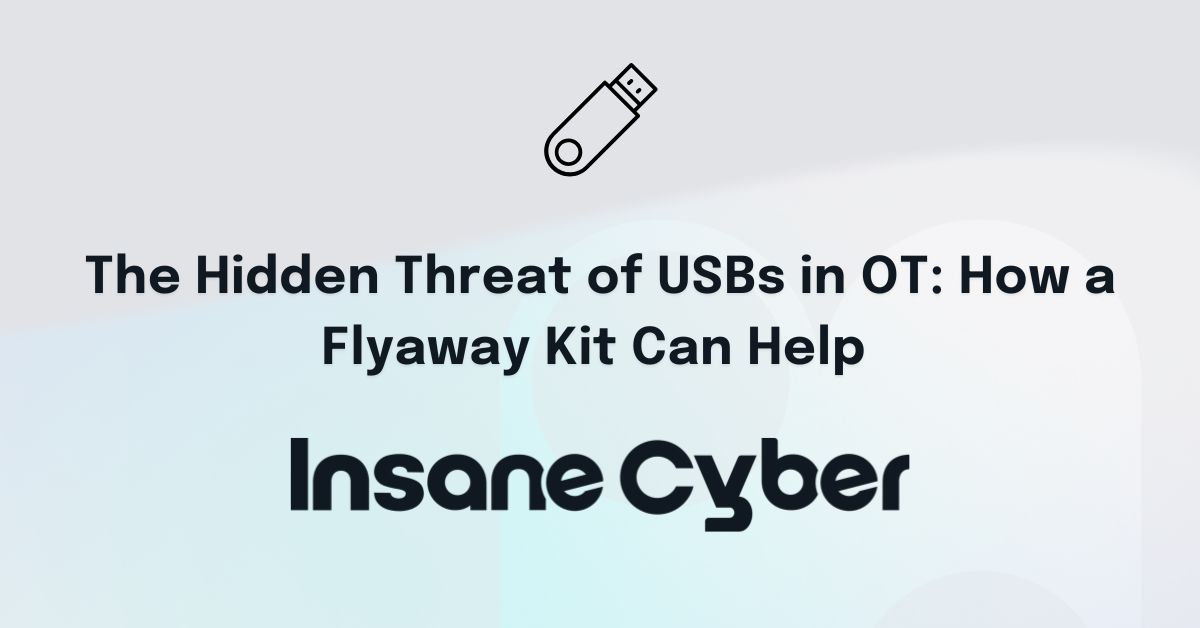In the world of operational technology (OT), the biggest security threats don’t always come from a sophisticated remote attacker. Sometimes, they walk right through the front gate in the form of a simple USB stick. These ubiquitous devices are essential for many tasks in industrial environments, from updating firmware and retrieving diagnostic logs to transferring configurations.
But for all their convenience, they represent one of the most significant and often overlooked vectors for malware and unauthorized access. For anyone responsible for the safety and reliability of critical infrastructure, the stakes are simply too high to leave this to chance. This is where a field-deployable solution, the flyaway kit, is changing the game by enabling secure and standardized USB testing on-site, even in the most remote or air-gapped locations.

The Unseen Danger of the Humble USB in OT
In industrial settings, a variety of personnel, including engineers, third-party vendors, and maintenance contractors, regularly use USB drives. This constant exchange of devices introduces a substantial risk. The infamous Stuxnet worm, which sabotaged Iran’s nuclear program, is a prime example of how devastating a USB-borne attack can be. It’s believed to have been introduced to the air-gapped facility via an infected USB drive, ultimately causing physical damage to centrifuges.
The challenge in many OT environments is a fundamental lack of visibility. It’s difficult to track every USB device that enters a facility, who it belongs to, and what data it contains. Traditional IT security measures often fall short, leaving a critical gap in defense.
Why Critical Infrastructure is Uniquely at Risk
A common misconception is that a lack of internet connectivity equates to security. However, in the OT world, this “air gap” can create a false sense of safety. The very nature of industrial control systems (ICS) means that USB devices are often connected directly to the most sensitive assets, such as Human-Machine Interfaces (HMIs), Programmable Logic Controllers (PLCs), and engineering workstations. A malicious payload on a USB drive can, therefore, bypass perimeter defenses and directly impact the physical processes that underpin our daily lives.
The air gap that is meant to protect these systems can, ironically, become a liability. Without a connection to the outside world, updating antivirus signatures on local scanning stations can be a challenge, and forensic data from a suspected incident can be difficult to extract and analyze.
When Traditional IT Tools Don’t Make the Cut
Simply repurposing IT-centric USB scanning solutions for OT environments is often a recipe for disaster. These tools are typically designed for internet-connected networks and may lack the necessary features for isolated industrial settings. They often fall short in providing the deep forensic logging and behavioral analysis required to understand the full scope of a potential threat.
Furthermore, OT systems require a non-intrusive approach. A scanning tool that inadvertently disrupts or crashes a critical process is not a viable solution. The unique protocols and legacy systems common in industrial environments demand a more tailored and controlled method for testing removable media.
The Flyaway Kit: Your Portable OT Security Outpost
This is where the concept of a flyaway kit becomes a critical asset. Imagine a rugged, portable case containing a self-sufficient cybersecurity toolkit. This is the essence of an OT flyaway kit. It’s designed to be deployed in the field, whether at a remote substation, a sprawling manufacturing plant, or a temporary field office, often with no need for an internet connection.

Inside an isolated environment provided by the kit, a USB device can be safely connected and thoroughly analyzed. These kits are equipped to detect a wide range of threats, from known malware signatures to unauthorized file types and even rogue devices that emulate keyboards to inject malicious commands. For incident response (IR) teams, a flyaway kit is invaluable. It allows them to test, triage, and respond to a potential USB-related incident directly on-site, drastically reducing the time from detection to remediation.
USB Threats in the Real World
Consider these common scenarios where a flyaway kit can be the difference between a close call and a catastrophic failure:
- The Third-Party Contractor: A contractor arrives at your facility with a USB drive containing a necessary firmware update for a critical piece of equipment. Before that drive is allowed anywhere near your control systems, it can be thoroughly vetted in the flyaway kit.
- The Well-Intentioned Engineer: A field engineer needs to pull data logs from a remote asset and only has their personal USB drive on hand. A quick scan in the flyaway kit can ensure their personal device doesn’t introduce an unknown threat.
- The “Found” USB: A USB drive is discovered lying on the floor near a control cabinet. Instead of a security policy that simply dictates it be destroyed, the flyaway kit allows for a safe and controlled analysis to determine if it was a targeted attack or an innocent mistake.
Cultivating a Culture of USB Hygiene in OT
Technology alone is not a silver bullet. It must be paired with robust security practices. Here are some fundamental principles for OT USB device hygiene:
- Trust, But Verify: Never allow an unknown or unverified USB device to be plugged into any ICS endpoint.
- Scan and Sanitize: Utilize flyaway kits or dedicated scanning kiosks to validate and whitelist all removable media before use.
- Log Everything: Maintain a detailed record of every USB interaction—who used it, what files were transferred, when it happened, and on which system.
Don’t Let a $10 Device Cause a $10 Million Outage
The convenience of USB drives will continue to make them a staple in OT environments. However, their potential for disruption cannot be ignored. It’s time to move beyond outdated policies and embrace a proactive approach to removable media security.
By evaluating your current USB policies and considering the deployment of flyaway kits at your substations, plants, and field offices, you can significantly reduce your risk profile and ensure that a simple, inexpensive device doesn’t become the root cause of a multi-million dollar incident.



